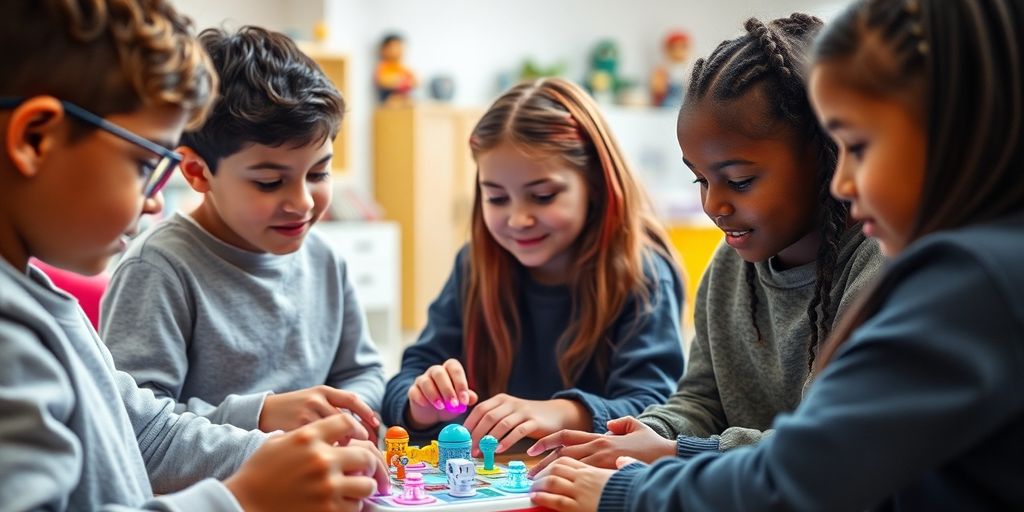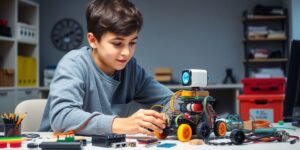In today’s tech-driven world, getting kids into coding early can be a game-changer. It’s not just about learning to code; it’s about sparking creativity and problem-solving skills. With 2025 around the corner, the latest AI coding toys are making it easier than ever to introduce preteens to the world of technology. From robotics to game development, these toys are paving the way for the next generation of innovators. Let’s dive into some of the best AI toys for preteens to learn coding and why they might just be the perfect gift for your tech-curious kid.
Key Takeaways
- AI coding toys can boost creativity and problem-solving skills in kids.
- Robotics kits are a fun way to introduce coding concepts.
- Interactive games and apps make learning coding engaging and accessible.
- LEGO sets offer hands-on experience with building and programming.
- Understanding AI concepts early can prepare kids for future tech challenges.
Innovative Robotics Kits for Young Coders
Exploring the Benefits of Robotics
Robotics is more than just assembling parts; it’s a gateway to understanding technology. Coding robots are fantastic tools for kids to learn programming in a hands-on way. They offer a blend of creativity and logic, making learning both fun and educational. These STEM toys are designed to spark curiosity and encourage exploration in the fields of science, technology, engineering, and math. Kids can see their code come to life, which boosts their confidence and problem-solving skills.
Top Robotics Kits for Preteens
When it comes to choosing the best robotics kits, there are several standout options:
- LEGO Mindstorms: This kit lets kids build and program robots with 601 pieces, including intelligent bricks and sensors. It’s a bit advanced, suitable for kids aged 10 and up.
- Wonder Workshop Dash: This cute, voice-activated robot is perfect for younger kids. It’s interactive and comes with free apps that make learning coding concepts fun.
- Makeblock mBot2: This engaging platform provides a hands-on experience with robotics and AI, ideal for preteens eager to dive into STEM subjects.
How Robotics Enhances Problem-Solving Skills
Robotics kits are not just toys; they are educational robots for learning programming. They help kids develop critical thinking and problem-solving skills by challenging them to find solutions to real-world problems. Through building and programming, children learn to think logically and sequentially. Coding robots for beginners age 9-12 are particularly effective because they provide immediate feedback, allowing kids to adjust their code and see the results instantly.
Robotics is more than just a hobby; it’s a way for kids to engage with technology in a meaningful way, preparing them for a future where these skills will be invaluable.
These robotics kits are among the best AI coding toys for preteens, offering a perfect blend of learning and play. They are not only entertaining but also foster a deeper understanding of programming and robotics, setting the stage for future tech-savvy innovators.
Engaging Coding Games and Apps
Best Coding Apps for Preteens
In today’s tech-savvy world, coding apps are a fantastic way for preteens to dive into the world of programming. They offer a mix of fun and learning, making complex coding concepts accessible. Here are some top picks:
- ScratchJr: Perfect for younger kids, this app allows them to create their own interactive stories and games.
- Hopscotch: Aimed at slightly older kids, it lets them build games and animations using simple coding blocks.
- Tynker: Offers a wide range of coding activities, from beginner to advanced levels, making it a versatile choice.
Interactive Games That Teach Coding
Interactive games can be a powerful tool for teaching coding. They keep kids engaged while subtly introducing them to computational thinking. Some noteworthy games include:
- Minecraft: Education Edition: Encourages creativity and problem-solving through coding challenges within the game.
- RoboZZle: A social puzzle game that teaches programming logic and functions.
- Lightbot: A puzzle game that uses programming logic to guide a robot to light up tiles.
How to Choose the Right Coding Game
Selecting the right coding game for your child can be tricky. Consider these factors:
- Age Appropriateness: Ensure the game matches your child’s age and skill level.
- Educational Value: Look for games that teach real coding skills and concepts.
- Engagement Level: Choose games that your child finds fun and engaging to keep their interest alive.
Tip: Introducing your child to coding games can spark a love for technology and problem-solving, setting them on a path to future success.
With these tools, preteens can explore the exciting world of coding, building skills that will serve them well in the future. Whether through Code Land or other engaging platforms, the journey to becoming a young coder is filled with fun and learning.
Hands-On Coding Projects for Kids
Encouraging kids to engage in hands-on coding projects is a fantastic way to spark their interest in programming. These projects not only provide a break from screen time but also allow children to apply coding concepts in creative ways. Interactive programming toys for children can transform abstract coding ideas into tangible experiences, making learning both fun and memorable.
Fun DIY Coding Projects
- Build a Simple Robot: Using basic components like motors, sensors, and microcontrollers, kids can assemble a small robot. This project introduces them to the fundamentals of robotics and programming.
- Create a Weather Station: With a few sensors and a microcontroller, children can build a device that measures temperature, humidity, and more. This project helps them understand data collection and analysis.
- Design a Light Show: By programming LEDs to light up in different patterns, kids can explore the basics of electronics and coding. This project is a great way to learn about circuits and programming logic.
Collaborative Coding Challenges
Working on projects with peers can enhance learning experiences. Here are some ideas:
- Team Coding Competitions: Organize small contests where groups of kids work together to solve coding problems. This fosters teamwork and problem-solving skills.
- Group Game Development: Kids can collaborate to create a simple game, learning about game design and coding.
- Community Coding Workshops: Host workshops where children can share their projects and learn from each other.
Building Real-World Applications
Turning ideas into real-world applications is a powerful way to learn coding:
- Develop a Simple App: Using visual programming platforms, kids can design an app that solves a problem or entertains.
- Program a Smart Home Device: With basic coding skills, children can create a device that automates tasks at home.
- Explore Programming Toys: These toys offer practical ways for kids to apply coding in everyday scenarios, bridging the gap between learning and real-world application.
Engaging in hands-on projects not only boosts kids’ coding skills but also builds confidence and creativity. By working on real-world applications, they see the impact of their ideas come to life, making programming for kids an exciting adventure.
Creative Coding with LEGO

LEGO Boost: A Gateway to Coding
LEGO Boost is like a dream come true for kids who love LEGO and want to try coding. It’s a perfect mix of fun and learning. With the LEGO Boost Creative Toolbox, kids can build and program five different models like Vernie the Robot and Frankie the Cat. This kit uses block-based coding, which is super easy for kids to pick up. All they need is a tablet with the LEGO Boost app, and they’re ready to go. Kids can make their creations move, talk, and even dance! It’s a great way to get them interested in coding without it feeling like schoolwork.
Building and Programming with LEGO MindStorm
LEGO MindStorm takes things up a notch. It’s for those who are ready to dive deeper into robotics and programming. This kit comes with 601 pieces, including motors and sensors, letting kids build robots that can do all sorts of cool things. They can use block-based coding to make robots walk, grab, and even shoot. The MindStorm EV3 Programmer App helps them control their creations with ease. Though it’s a bit more complex than LEGO Boost, it’s perfect for kids who are ready to challenge themselves and explore the world of coding in a fun, hands-on way.
The Educational Value of LEGO Coding
LEGO coding sets like Boost and MindStorm are more than just toys. They’re powerful educational tools. Kids learn problem-solving, critical thinking, and even some basic engineering concepts while having a blast. Plus, they get to see their code come to life. It’s a great way to introduce kids to STEM concepts early on. These kits make learning interactive and engaging, which can spark a lifelong interest in technology and science. By using block-based coding with LEGO, kids can easily grasp coding fundamentals while enjoying the creative process.
AI-Powered Learning Tools

Understanding AI Concepts for Kids
AI is reshaping how we learn, and for kids, it’s not just about understanding technology—it’s about preparing for the future. By introducing AI concepts early, kids can develop skills like problem-solving and logical thinking. AI toys that teach JavaScript to kids are a great way to start. These toys are designed to make learning interactive and fun, ensuring that children remain engaged while acquiring new skills.
Best AI Toys for Preteens to Learn Coding
When it comes to AI education, there are several standout toys that make the learning process exciting for preteens:
- Cozmo Robot: This little robot is not just adorable; it’s a powerful tool for teaching coding and AI concepts.
- LEGO Mindstorms: Combining the fun of building with the challenge of programming, this kit is perfect for hands-on learners.
- Botley 2.0: A screen-free coding robot that introduces kids to the basics of coding in a playful manner.
These toys not only teach coding but also encourage creativity and critical thinking, making them ideal educational technology tools.
How AI Enhances Learning Experiences
AI is not just a subject to learn; it’s a tool that transforms how learning happens. With AI, educational experiences become more personalized, adapting to each child’s pace and style. This means kids can learn more effectively, focusing on areas where they need the most help. AI-powered learning tools make this possible by providing real-time feedback and adjusting challenges to keep kids motivated.
Learning through play has never been more effective, thanks to AI. It turns everyday activities into opportunities for growth, ensuring that education is both fun and impactful.
Building Computers and Hardware Skills

Kano Computer Kit: Build Your Own PC
Building a computer from scratch might sound like a job for tech gurus, but with the Kano Computer Kit, it’s a task even preteens can tackle. This tech toy turns STEM education into a hands-on experience, letting kids assemble a computer that they can actually use. The kit includes everything from a Raspberry Pi to a keyboard and a step-by-step guide that makes the process as simple as pie. Kids learn not only how to put the pieces together but also gain insights into what each component does. It’s a fantastic way to demystify technology and spark an interest in how things work.
Hands-On Hardware Projects
Engaging with hardware projects can be a thrilling adventure for kids. Here are some projects that can boost their confidence and skills:
- LED Light Shows: Create a light show with programmable LEDs. It’s fun and teaches basic programming.
- Simple Robots: Build a basic robot using motors and sensors. Kids can program it to perform simple tasks.
- Weather Station: Set up a weather station using sensors to monitor temperature and humidity. It’s a practical project that shows real-world applications.
The Importance of Hardware Knowledge in Coding
Understanding hardware is crucial for anyone interested in coding. It gives kids a solid foundation in how software interacts with physical components. This knowledge is especially important as they begin to explore more advanced coding projects. Knowing how to troubleshoot hardware can also be a valuable skill, preventing frustration when things don’t work as expected. Plus, it’s a great way to understand the broader picture of how technology shapes our world.
Building hardware skills is not just about learning to code; it’s about understanding the building blocks of our digital world. With the right tools and guidance, kids can transform their curiosity into real-world skills, setting the stage for future innovation.
For parents looking to expand their child’s horizons, consider tech toys that combine fun with education, like coding summer camps designed by experts from Google, MIT, and Stanford.
Exploring the World of Game Development

Introduction to Game Design for Preteens
Game design is like a playground for creativity. Kids can use their imagination to build worlds and tell stories. Starting young can spark a lifelong interest in technology and creativity. Preteens often enjoy the challenge of creating something new and seeing it come to life. It’s not just about playing games; it’s about understanding how they work and what makes them fun. Learning game design helps kids think critically and solve problems, skills that are useful in many areas of life.
Tools for Aspiring Game Developers
There are plenty of tools available for young game developers. Programs like Scratch and Unity provide platforms for kids to learn coding and design. Scratch is great for beginners, allowing them to create simple animations and games with drag-and-drop coding blocks. Unity, on the other hand, is more advanced and used by professionals to create 3D games. Kids can start with Scratch and move to Unity as they become more confident. These tools teach valuable skills that are applicable in many tech fields.
Creating Games with Scratch and Unity
Making games with Scratch and Unity is like building a digital playground. With Scratch, kids can make simple games by snapping together code blocks. It’s easy to use and perfect for beginners. Unity offers more complexity, allowing kids to create detailed 3D games. They can learn about physics, animation, and even artificial intelligence. By experimenting with these tools, kids can understand the basics of game development and explore their creativity. This hands-on experience is invaluable for those interested in a future in tech.
Conclusion
In the end, the world of AI coding toys is more than just a trend—it’s a gateway to the future for our preteens. These toys aren’t just about having fun; they’re about learning skills that will be crucial in tomorrow’s world. Whether your child is building robots, coding games, or exploring new tech, they’re gaining valuable experience that could shape their future careers. So, as you consider which toys to introduce to your child, think about the skills they can develop and the doors these toys can open. Who knows? You might just be nurturing the next great innovator. It’s an exciting time to be a kid with a passion for technology.
Frequently Asked Questions
What are some of the best coding toys for preteens in 2025?
Some top coding toys for preteens in 2025 include LEGO Boost, Kano Computer Kit, and Wonder Workshop Dash. These toys make learning coding fun and interactive.
How can robotics kits help my child learn coding?
Robotics kits teach kids coding by allowing them to build and program robots. This hands-on approach helps them understand coding concepts and improve problem-solving skills.
Are there any coding games that can make learning fun for kids?
Yes, there are many interactive coding games and apps like Scratch and Code.org that make learning to code enjoyable and engaging for kids.
Why is it important for kids to learn coding and AI?
Learning coding and AI helps kids develop critical thinking and problem-solving skills. It prepares them for future careers in technology and other fields.
What should I consider when choosing a coding toy for my child?
Consider your child’s age, interests, and skill level. Look for toys that offer a balance of fun and educational value, and that provide opportunities for hands-on learning.
Can building computers help kids with coding skills?
Yes, building computers helps kids understand hardware and software interactions, enhancing their coding skills and overall understanding of technology.



